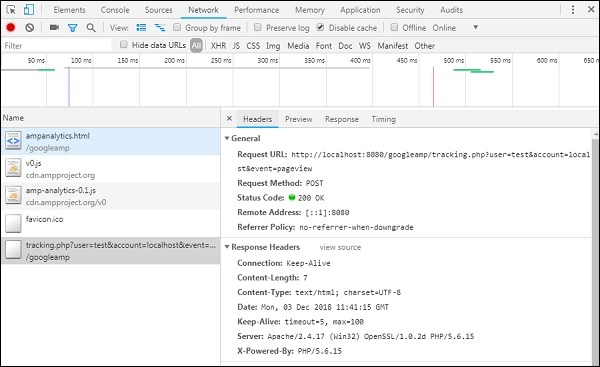
- Google AMP 教程
- Google AMP - 首頁
- Google AMP - 概述
- Google AMP - 簡介
- Google AMP - 圖片
- Google AMP - 表單
- Google AMP - 內嵌框架
- Google AMP - 影片
- Google AMP - 按鈕
- Google AMP - Timeago
- Google AMP - Mathml
- Google AMP - 適應文字
- Google AMP - 日期倒計時
- Google AMP - 日期選擇器
- Google AMP - 故事
- Google AMP - 選擇器
- Google AMP - 連結
- Google AMP - 字型
- Google AMP - 列表
- Google AMP - 使用者通知
- Google AMP - 下一頁
- Google AMP - 屬性
- 樣式和自定義 CSS
- Google AMP - 動態 CSS 類
- Google AMP - 操作和事件
- Google AMP - 動畫
- Google AMP - 資料繫結
- Google AMP - 佈局
- Google AMP - 廣告
- Google AMP - 分析
- Google AMP - 社交小部件
- Google AMP - 媒體
- HTML 頁面到 AMP 頁面
- Google AMP - 基本語法
- Google AMP - 驗證
- Google AMP - 快取
- Google AMP - 自定義 Javascript
- Google AMP - CORS
- Google AMP 有用資源
- Google AMP - 快速指南
- Google AMP - 有用資源
- Google AMP - 討論
Google AMP - 自定義 Javascript
在前面的章節中,我們學習了許多 amp 元件。我們還了解到,每個元件要工作都需要新增一個 javascript 檔案。
例如,對於 amp-iframe,新增的指令碼如下:
<script async custom-element="amp-iframe" src="https://cdn.ampproject.org/v0/amp-iframe-0.1.js"> </script>
我們在 script 標籤中添加了 async。這是 amp 的標準,因為它們非同步載入所有 javascript 檔案。還添加了一個 custom-element 屬性,其中包含它所用元件的名稱。
如果要使用任何 amp 元件,並且它不是核心 amp javascript 檔案的一部分,則必須如上所示新增指令碼。
我們大多習慣於在頁面內編寫大量 javascript 程式碼,以及使用 script 標籤包含 javascript 檔案。
如何在 amp 中做到這一點?因此,AMP 不允許編寫任何指令碼程式碼或從外部載入 script 標籤。
Amp 有自己的元件來處理本應由頁面上新增的額外指令碼完成的任務。這主要是出於效能方面的考慮,以便更快地載入頁面內容,並且不會讓 javascript 延遲渲染或對 DOM 進行任何更改。
這是 AMP 根據其官方網站 為 script 標籤提供的規範:
除非型別為 application/ld+json,否則禁止使用。(根據需要可以新增其他非可執行值。)例外情況是載入 AMP 執行時的必需 script 標籤和載入擴充套件元件的 script 標籤。
這裡顯示了一個工作示例,我們可以在其中在 amp 頁面內使用 application/ld+json。請注意,我們正在使用型別為“application/ld+json”的 script 標籤,以便 amp-analytics 元件觸發跟蹤器。
類似地,我們可以在需要時在其他 amp 元件上使用型別為“application/ld+json”的 script 標籤。
示例
<!doctype html>
<html amp>
<head>
<meta charset = "utf-8">
<title>amp-analytics</title>
<script async src = "https://cdn.ampproject.org/v0.js">
</script>
<script async custom-element = "amp-analytics"
src = "https://cdn.ampproject.org/v0/amp-analytics-0.1.js">
</script>
<link rel = "canonical" href = "ampanalytics.html">
<meta name = "viewport" content = "width=device-width,
minimum-scale = 1,initial-scale = 1">
<style amp-boilerplate>
body{
-webkit-animation:
-amp-start 8s steps(1,end) 0s 1 normal both;-moz-animation:
-amp-start 8s steps(1,end) 0s 1 normal both;-ms-animation:
-amp-start 8s steps(1,end) 0s 1 normal both;animation:
-amp-start 8s steps(1,end) 0s 1 normal both
}
@-webkit-keyframes
-amp-start{from{visibility:hidden}to{visibility:visible}}@-moz-keyframes
-amp-start{from{visibility:hidden}to{visibility:visible}}@-ms-keyframes
-amp-start{from{visibility:hidden}to{visibility:visible}}@-o-keyframes
-amp-start{from{visibility:hidden}to{visibility:visible}}@keyframes
-amp-start{from{visibility:hidden}to{visibility:visible}}
</style>
<noscript>
<style amp-boilerplate>
body{
-webkit-animation:none;
-moz-animation:none;
-ms-animation:none;
animation:none}
</style>
</noscript>
</head>
<body>
<h1>Google Amp - Analytics</h1>
<amp-analytics>
<script type = "application/json">
{
"requests": {
"event": "https://:8080/googleamp/tracking.php?
user=test&account=localhost&event=${eventId}"
},
"triggers": {
"trackPageview": {
"on": "visible",
"request": "event",
"vars": {
"eventId": "pageview"
}
}
}
}
</script>
</amp-analytics>
</body>
</html>
當瀏覽器中訪問頁面時,將觸發頁面瀏覽量的跟蹤器。可以在 Google 的網路選項卡中看到,如下所示。
